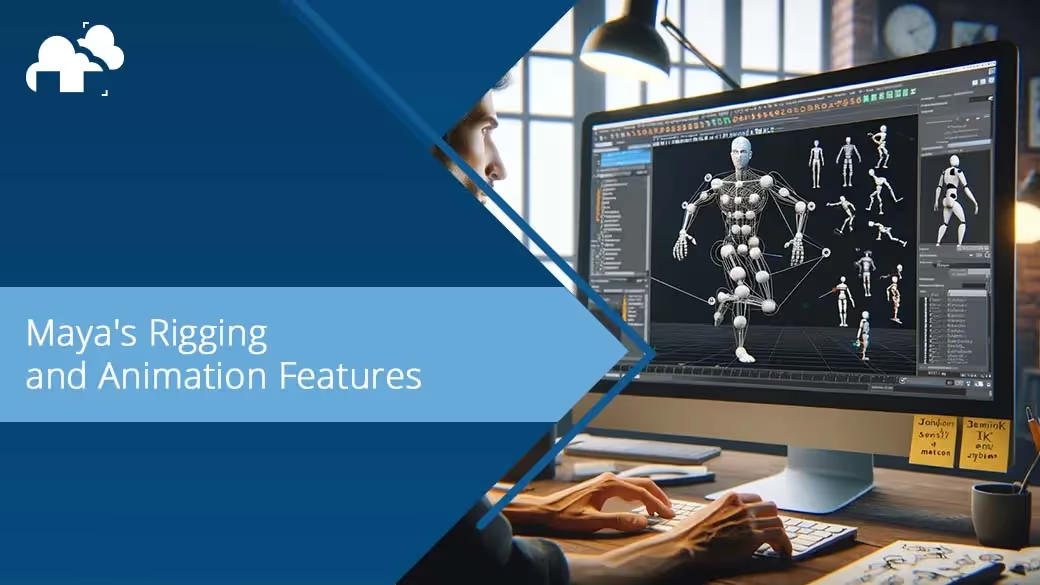Maya's rigging and animation features
Autodesk Maya has long been revered in the digital content creation realm, particularly in the disciplines of rigging and animation. This software's unparalleled capabilities stem from a robust suite of features designed to meet the intricate demands of these processes. Maya Character Animation is not merely about bringing meshes to life; it's about doing so with a level of finesse and control that few other software packages can match.
Maya’s popularity among larger studios makes it so there is no shortage of plugins and Maya Render Farm services available to facilitate integration to almost any pipeline. In this article, we delve into the specific features of Maya that cement its status as the premier choice for rigging and animation professionals.
Rigging features in Maya
- Joint and Bone Creation Tools: Maya's intuitive tools for creating and positioning joints and bones are fundamental for building the skeleton of a character or object, providing the framework upon which movements are based.
- Inverse Kinematics (IK) and Forward Kinematics (FK): Moving between Forward Kinematics vs Inverse Kinematics in Maya allows for flexibility and comprehensiveness. FK is typically used for animating in a chain-like fashion, such as arms or legs, where you set angles of joints. IK, on the other hand, allows for the end effector (like a hand or foot) to be positioned, and the system calculates the angles of the joints automatically. With its advanced IK and FK systems, Maya offers animators the flexibility to choose the most appropriate method for animating movements, whether it's for the natural motion of limbs or mechanical movements in machinery.
- HumanIK: Maya Rigging Controls via the HumanIK system provide an integrated solution for character rigging and animation, offering full-body inverse kinematics (IK) and retargeting capabilities. Thanks to HumanIK, rigging a biped in Maya is more advanced than the solutions typically found in other popular DCCs.
- Skinning and Weight Painting: Skinning in Maya allows for seamless attachment of the mesh to the skeleton, while weight painting tools enable precise control over how different parts of the mesh respond to joint movements.
- Deformers and Blend Shapes: These tools are essential for creating complex, nuanced movements and enabling characters to convey a wide range of emotions and actions. Maya Blend shapes, in particular, are key for facial animation, allowing for the mixing of different shapes (or morph targets) to create expressions.
- Nonlinear Deformation Tools: Maya includes features like lattice and cluster deformers, which are non-destructive and provide additional control over mesh deformation, allowing for more detailed and specific movements and transformations.
- nCloth and nHair: While these are more on the simulation side, they interact closely with the rigging system in Maya. The nCloth and nHair systems provide sophisticated simulation options for cloth and hair, which can be integrated into rigs for dynamic, realistic movements that are generally more advanced than the cloth and hair simulation tools in their counterparts in other software.
- Muscle and Skin Simulation: The Maya muscle system offers a complex muscle system that allows for the creation of rigs that mimic the underlying muscular movements, contributing to more realistic deformations of the skin during animations. This system is particularly detailed in Maya and is designed for high-end animation work, whereas other widely used programs have more basic muscle simulation features.
Animation features in Maya
- Graph Editor and Dope Sheet: These tools are pivotal for animators to fine-tune the timing and flow of movements, providing a detailed view of animation curves and keyframe placement.
- Motion Capture and Retargeting: Maya's robust motion capture integration and retargeting capabilities allow animators to apply real-life movements to their digital characters, enhancing realism and reducing manual keyframing.
- Time Editor: This non-linear editing system for animation clips enables animators to blend, sequence, and modify animation takes, streamlining the animation process and enhancing creative control.
- Animation Layering: With this feature, animators can create and manage multiple layers of animation, each with its own set of keyframes, allowing for more complex and nuanced character performances.
- Real-time Animation Playback: Maya's Viewport 2.0 provides real-time feedback, allowing animators to preview their work in a high-quality display without the need for time-consuming rendering.
Why Maya reigns supreme in rigging and animation
The integration of these features into a cohesive and user-friendly environment is what sets Maya apart. The software’s ability to handle both simple and highly complex rigging and animation tasks makes it a versatile tool suitable for a wide range of projects. Here’s why Maya maintains its leading position:
- Scalability: From indie projects to blockbuster films, Maya scales to the needs of the project, handling complexity with ease
- Customizability: Through MEL and Python scripting, users can tailor Maya to their specific workflow requirements, automating tasks and creating bespoke tools
- Interoperability: Maya's seamless integration with other software tools, including motion capture systems and game engines, ensures a smooth pipeline from concept to final render.
- Community and Support: A strong user community, along with Autodesk’s commitment to continuous improvement, means users have access to extensive resources, tutorials, and technical support.
Conclusion
Maya's comprehensive features for rigging and animation are not just about the tools themselves but how they work together to form a powerful, integrated system. This synergy, combined with the software’s adaptability and support structure, makes Maya the preferred choice for professionals across the animation and visual effects industries. Whether for intricate character rigging, dynamic animation, or a blend of both, Maya stands as a testament to what is possible when technology meets creativity, solidifying its status as the go-to software for rigging and animation.
